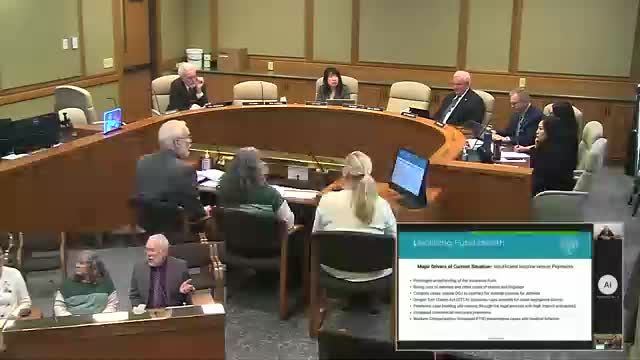Oregon Insurance Fund faces $10M monthly liabilities amid rising litigation costs
February 25, 2025 | General Government, Ways and Means, Joint, Committees, Legislative, Oregon
This article was created by AI summarizing key points discussed. AI makes mistakes, so for full details and context, please refer to the video of the full meeting. Please report any errors so we can fix them. Report an error »

Oregon's insurance fund is facing a critical crisis, with costs spiraling out of control due to a surge in lawsuits and claims. During a recent meeting of the Joint Committee on Ways and Means Subcommittee on General Government, officials revealed that the state is currently running at a staggering $10 million per month in ongoing fees and costs, primarily driven by complex and lengthy litigation.
The discussion highlighted the impact of the Oregon Tort Claims Act, which has seen annual increases in caps, coupled with a rise in federal civil rights claims that lack such limits. This combination has led to a significant uptick in claims, particularly on the federal side, exacerbated by the financial strain of the pandemic and rising commercial insurance premiums.
Chair Gomberg and committee members expressed concern over the declining health of the insurance fund, noting that over the past eight years, the fund has been underfunded by approximately $150 million. This chronic underfunding has resulted in a precarious situation where the fund's liabilities are outpacing its income, leading to a forecasted balance of only $30 to $40 million by the end of the biennium.
The meeting also addressed specific high-cost claims, including a class action lawsuit against the Oregon Department of Corrections related to COVID-19 protocols, which is still in litigation. Other significant cases involve the Department of Human Services, with ongoing costs that have accumulated over the years.
As the committee grapples with these challenges, they are considering mitigation efforts, including a proposed budget request of $3 million aimed at stabilizing the fund. However, officials warned that regaining the fund's health will take time and require careful management of resources.
The urgency of the situation was underscored by the metaphor of a car in need of oil—if not addressed, the state risks facing a much larger problem down the road. The committee's discussions signal a critical juncture for Oregon's insurance fund, with potential implications for state operations and financial stability.
The discussion highlighted the impact of the Oregon Tort Claims Act, which has seen annual increases in caps, coupled with a rise in federal civil rights claims that lack such limits. This combination has led to a significant uptick in claims, particularly on the federal side, exacerbated by the financial strain of the pandemic and rising commercial insurance premiums.
Chair Gomberg and committee members expressed concern over the declining health of the insurance fund, noting that over the past eight years, the fund has been underfunded by approximately $150 million. This chronic underfunding has resulted in a precarious situation where the fund's liabilities are outpacing its income, leading to a forecasted balance of only $30 to $40 million by the end of the biennium.
The meeting also addressed specific high-cost claims, including a class action lawsuit against the Oregon Department of Corrections related to COVID-19 protocols, which is still in litigation. Other significant cases involve the Department of Human Services, with ongoing costs that have accumulated over the years.
As the committee grapples with these challenges, they are considering mitigation efforts, including a proposed budget request of $3 million aimed at stabilizing the fund. However, officials warned that regaining the fund's health will take time and require careful management of resources.
The urgency of the situation was underscored by the metaphor of a car in need of oil—if not addressed, the state risks facing a much larger problem down the road. The committee's discussions signal a critical juncture for Oregon's insurance fund, with potential implications for state operations and financial stability.
View full meeting
This article is based on a recent meeting—watch the full video and explore the complete transcript for deeper insights into the discussion.
View full meeting
